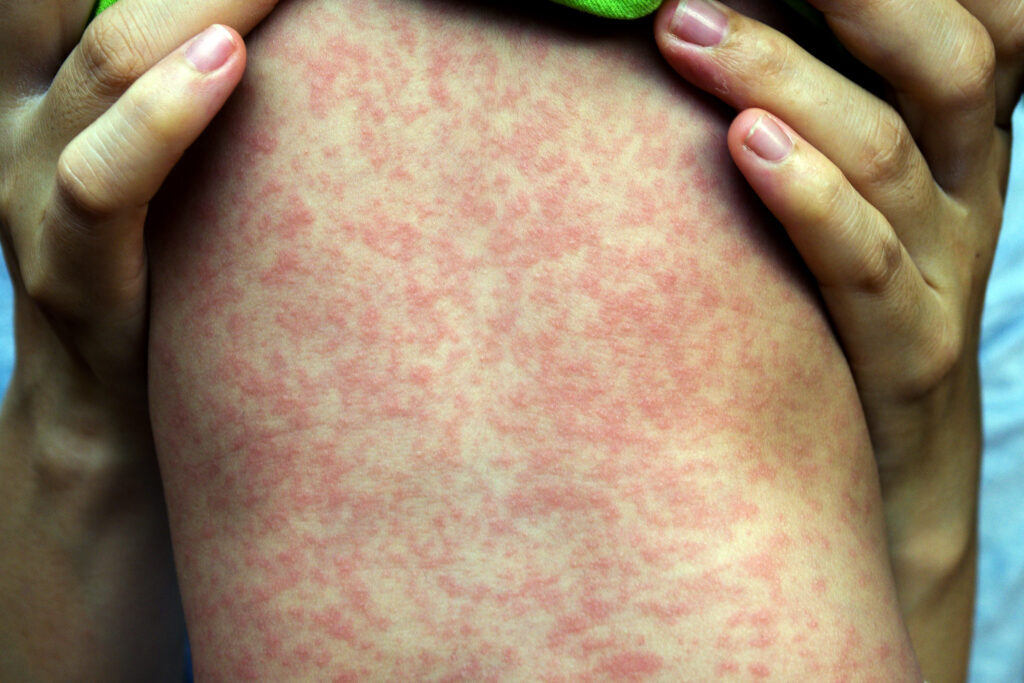As you’ve probably heard, there is a new measles outbreak in the United States. It started in Texas and has now spread to New Mexico, with scattered cases reported in other states.1
So far, over 250 people have contracted measles and, sadly, two deaths have been reported—one of them a child.2
More Details About the Ongoing Outbreak…
- The measles outbreak originated in Gaines County, Texas, an area known for low vaccination rates.3
- The 2 individuals who died from measles included a school-aged child in Texas and an adult in New Mexico. Neither were vaccinated against measles.4
- These are the first measles-related deaths in the U.S. since 2015.5
- The Mennonite community in Texas has been hit particularly hard by this current outbreak.6
What Causes Measles?
It’s caused by the measles virus.
What are the Signs & Symptoms of Measles?
The Classic Signs & Symptoms of Measles Include:
- The “3 Cs”—a cough, coryza (a runny nose), and conjunctivitis (pink eye).
- A high fever.
- A head-to-toe rash.
- Koplik spots—tiny white spots in the mouth surrounded by a red ring.
- Organ involvement (think: pneumonia or a brain infection) in severe cases.
Here’s a Typical Measles Presentation:
Day 1: The child develops cold-like symptoms (a cough and a runny nose) plus pink eye and a robust fever.
Days 3 & 4: Koplik spots appear in the mouth.
Days 5 & 6: An impressive rash breaks out all over the child’s body. At this point, the virus may travel to other organs (such as the lungs or the brain) and infect them.
Insider Info:
The measles rash usually starts out on the face. It then moves down, spreading to the chest, back, arms, and legs. The rash is characterized by multiple small red bumps that coalesce to form larger red patches (as in the pic below).

Ugh, I Don’t Like the Sound of That. How is the Measles Virus Spread?
The measles virus is spread through tiny airborne droplets. When a person with measles coughs, sneezes, or even breathes into the air, they release these droplets. If another person comes along and breathes in the droplets or touches a surface with the droplets on them and then brings their hands to their mouth, they can get measles.
Insider Info: The measles virus can survive in the air and on surfaces for up to 2 hours.7
Is Measles Contagious?
Yes—measles is super contagious IF you don’t have any immunity to it.
In fact, studies show that 90% of people who are unvaccinated against measles will be infected by it if they have a close exposure to someone with measles.8
It’s a different story, though, if you’re vaccinated against measles.
Ok, What’s the Deal If My Child IS Vaccinated Against Measles?
The measles vaccine (which is typically given in combination with other vaccines) works well! It’s usually given as part of the MMR (measles, mumps, and rubella) vaccine between 12-15 months of age and as part of the MMRV (MMR plus chickenpox vaccine) between 4-6 years of age.
- One dose of the MMR vaccine is 93% effective at preventing measles.9
- Two doses are about 97% effective, providing long-term immunity.10
- Insider Info: Breakthrough cases are rare and are usually much milder than they are in unvaccinated individuals.11
How Do I Protect My Child From Measles If They’re Under 1 Year of Age & Haven’t Received the MMR Vaccine.
Although Kids Under 1 Year are Considered Particularly Vulnerable to Measles, There are Certain Steps That You Can Take to Protect Your Child From It. They Are:
1. Limit Your Child’s Exposure to Crowded or High-Risk Areas.
Avoid taking your baby to places with large crowds, especially in areas with measles outbreaks. Be cautious in airports, daycare centers, and international travel destinations where measles is more common.
2. Ensure That Your Child’s Close Contacts Are Vaccinated.
Make sure that all family members, caregivers, and visitors are fully vaccinated with the MMR vaccine. This will create a “protective shield” around your baby. Encourage relatives and friends to get the vaccine if they haven’t already.
3. Practice Good Hygiene.
Wash your hands frequently with soap and water. Disinfect surfaces and objects that your baby frequently touches.
4. Keep Your Distance From “Sick Contacts.”
Avoid close contact with anyone showing symptoms of measles (think: a fever, a cough, red eyes, or the telltale rash).
5. Offer Breast Milk (If Possible).
If you’re a breastfeeding or pumping Mama and you’re vaccinated against measles (or you had measles in the past), your breast milk may provide some antibodies to temporarily help protect your baby. That being said, this protection is not 100% effective, so other precautions are still necessary.
6. Consider Early Vaccination for Travel.
If you must travel internationally or to a high-risk area, consult your pediatrician about giving the MMR vaccine as early as 6 months.
Insider Info: Your baby will still need the routine doses at 12–15 months and 4–6 years for full immunity (and for them to be counted in their school record).
What Should I Do If My Child is EXPOSED to Measles (i.e. If They Come in Contact With Someone With Measles or Are in an Area Affected by a Measles Outbreak)?
Good Question! The Next Steps Depend on Your Child’s Age and Vaccination Status.
1. For Children Who Haven’t Received ANY Doses of the MMR Vaccine (e.g. Babies Under 1 Year and Older Children Who Haven’t Been Vaccinated Yet):
If your child hasn’t been vaccinated yet and is over 1 year old, they can get the vaccine right away.
Babies under 1 year can get the MMR vaccine early—as early as 6 months of age.12
Note: As mentioned above, babies who get the MMR vaccine early (before 1 year) still need to get their routine doses at 12–15 months and 4–6 years for full immunity (and to count towards their school immunization record).
2. For Children Who Have Received 1 Dose of the MMR Vaccine:
If the exposure occurs after your child has received their first dose of MMR, the second (booster) dose of MMR can be moved up if needed. This second dose can be given as early as 28 days after the first dose.13
3. For Children Who Have Received 2 Doses of the MMR Vaccine (Both After 1 Year of Age):
These children are considered fully immunized against measles and don’t need any additional vaccines or booster doses.14
Just monitor for symptoms 7-21 days after the exposure and let their doctor know ASAP if any develop.
PediaTip: If you’re unsure about your child’s vaccine status, their doctor can do a blood test (a “measles immunity test”) to check for antibodies to the virus.
How is Measles Treated?
Because measles is caused by a virus, antibiotics unfortunately won’t work against it. This is why prevention is key. If your child contracts measles, their doctor will recommend “supportive care.”
This Includes:
- Rest
- Keeping your child hydrated.
- Managing their fevers with Tylenol or Motrin (remember: Motrin is only for kids 6 months & older).
- Giving Vitamin A supplements if their doctor recommends it.
Why? Because Vitamin A deficiency can make measles more severe. Docs may give vitamin A supplements to help reduce complications, especially in malnourished or young children.
- Running a cool-mist humidifier in their room at night.
Cool-mist humidifiers help keep the skin lining the nasal passages moist and the mucus loose.
PediaTips:- Be sure to clean the humidifier daily (see the manufacturer’s manual) to prevent the growth of mold and bacteria.
- Avoid hot-water vaporizers. Why? Because they can cause burns.
In addition, you’ll want to look out for any red flag symptoms that would require a trip to the ER. For example—trouble breathing, dehydration, and lethargy.
The Bottom Line
The current measles outbreak is striking fear in the hearts of many pediatricians and parents—especially those with children under 1 year old. Fortunately, the MMR vaccine is highly effective and can be given as early as 6 months for babies who have been exposed to measles.








